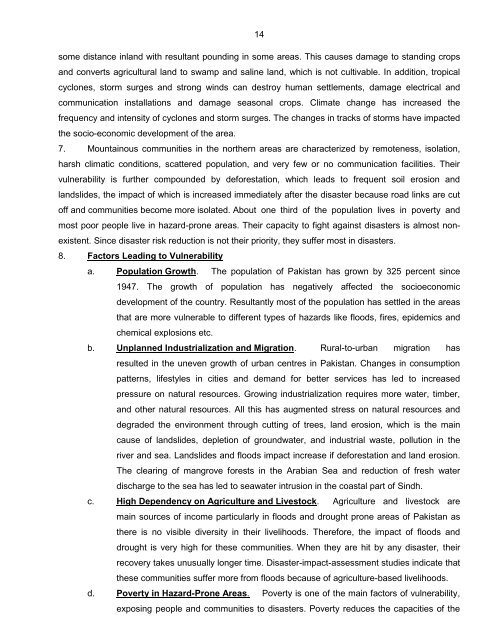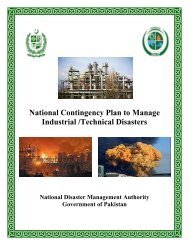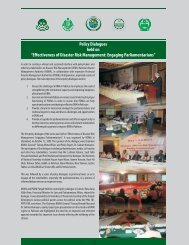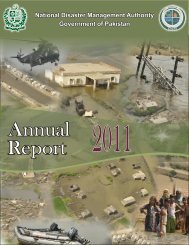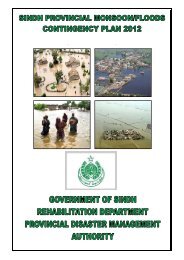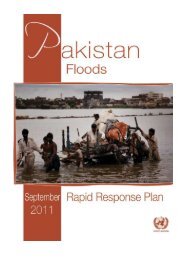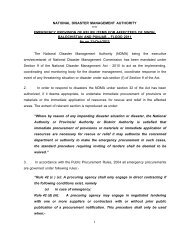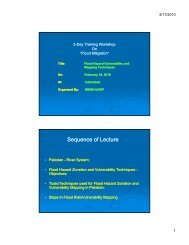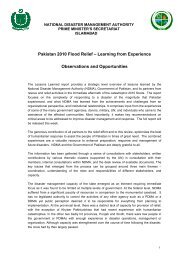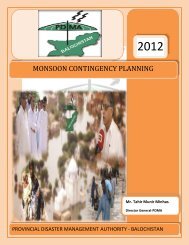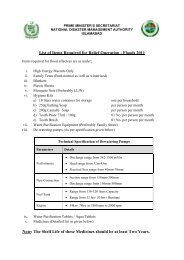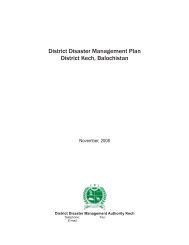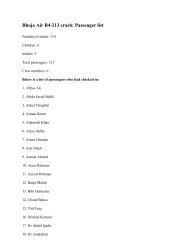National Disaster Response Plan (NDRP) March 2010 - NDMA
National Disaster Response Plan (NDRP) March 2010 - NDMA
National Disaster Response Plan (NDRP) March 2010 - NDMA
Create successful ePaper yourself
Turn your PDF publications into a flip-book with our unique Google optimized e-Paper software.
14<br />
some distance inland with resultant pounding in some areas. This causes damage to standing crops<br />
and converts agricultural land to swamp and saline land, which is not cultivable. In addition, tropical<br />
cyclones, storm surges and strong winds can destroy human settlements, damage electrical and<br />
communication installations and damage seasonal crops. Climate change has increased the<br />
frequency and intensity of cyclones and storm surges. The changes in tracks of storms have impacted<br />
the socio-economic development of the area.<br />
7. Mountainous communities in the northern areas are characterized by remoteness, isolation,<br />
harsh climatic conditions, scattered population, and very few or no communication facilities. Their<br />
vulnerability is further compounded by deforestation, which leads to frequent soil erosion and<br />
landslides, the impact of which is increased immediately after the disaster because road links are cut<br />
off and communities become more isolated. About one third of the population lives in poverty and<br />
most poor people live in hazard-prone areas. Their capacity to fight against disasters is almost non-<br />
existent. Since disaster risk reduction is not their priority, they suffer most in disasters.<br />
8. Factors Leading to Vulnerability<br />
a. Population Growth. The population of Pakistan has grown by 325 percent since<br />
1947. The growth of population has negatively affected the socioeconomic<br />
development of the country. Resultantly most of the population has settled in the areas<br />
that are more vulnerable to different types of hazards like floods, fires, epidemics and<br />
chemical explosions etc.<br />
b. Unplanned Industrialization and Migration. Rural-to-urban migration has<br />
resulted in the uneven growth of urban centres in Pakistan. Changes in consumption<br />
patterns, lifestyles in cities and demand for better services has led to increased<br />
pressure on natural resources. Growing industrialization requires more water, timber,<br />
and other natural resources. All this has augmented stress on natural resources and<br />
degraded the environment through cutting of trees, land erosion, which is the main<br />
cause of landslides, depletion of groundwater, and industrial waste, pollution in the<br />
river and sea. Landslides and floods impact increase if deforestation and land erosion.<br />
The clearing of mangrove forests in the Arabian Sea and reduction of fresh water<br />
discharge to the sea has led to seawater intrusion in the coastal part of Sindh.<br />
c. High Dependency on Agriculture and Livestock. Agriculture and livestock are<br />
main sources of income particularly in floods and drought prone areas of Pakistan as<br />
there is no visible diversity in their livelihoods. Therefore, the impact of floods and<br />
drought is very high for these communities. When they are hit by any disaster, their<br />
recovery takes unusually longer time. <strong>Disaster</strong>-impact-assessment studies indicate that<br />
these communities suffer more from floods because of agriculture-based livelihoods.<br />
d. Poverty in Hazard-Prone Areas. Poverty is one of the main factors of vulnerability,<br />
exposing people and communities to disasters. Poverty reduces the capacities of the


